
I am honored to be one of 40 students named to Cohort One of the Geller International Fellowship, a program designed and managed by the Israel on Campus Coalition (ICC). Learn more about the program in my announcement from October 2022 here.
As part of the trip, Cohort One is traveling to Israel and the United Arab Emirates over the course of ten days. We leave on January 2, 2023.
I'm taking diligent notes (and a lot of photos) during our travels, and I will be publishing some updates to this page below.
Sidenote: I'm referring to these updates as "The Geller Machberet." The Hebrew word מחברת means "notebook." It's a subtle — okay, not so subtle — homage to the notebook I'm carrying around while we travel (and my four semesters of Hebrew!).
I am beyond thankful to the Israel on Campus Coalition and its staff for selecting me for this opportunity and putting this outstanding trip together. I'm elated to update this post daily with some words, pictures, and general takeaways!
January 2
WHERE I AM: New York City, New York, USA
LOCAL TIME: 6:47 PM EST
I'm writing to you from John F. Kennedy International Airport in New York City. My flight from Washington DC — where I have been spending the last few days with family — just touched down at North America's busiest international gateway.
As I make my way to the Delta international terminal, I'm thinking about some of my plans for the long ten-hour journey ahead of us to Tel Aviv. I have two books that I'm excited to read:
The Power of Geography: Ten Maps that Reveal the Future of Our World (Tim Marshall) explains geopolitics through the lens of geography. I started this book on the plane flight from Indianapolis to Washington DC, and I'm really enjoying it thus far.
The Bomber Mafia: A Dream, a Temptation, and the Longest Night of the Second World War (Malcolm Gladwell) is a book I picked up at a bookstore. I know nothing else about it beyond what the title tells us. Why did I not read the synopsis on the back cover before purchasing it? That's because I'll buy almost any Malcolm Gladwell book you show me. Whatever you may think of Malcolm Gladwell (and I've admired him and criticized him at various points), almost everyone would agree he's a talented storyteller. So I'm excited to read whatever this story may be.
When I'm not reading, you'll probably find me watching a movie or listening to some Taylor Swift music. Big surprise, I know.
Anyway, let the trip begin! I'll be back to update this blog tomorrow once we arrive in Israel. I'll be on Israel Standard Time for the first leg of the trip, so I'm seven hours ahead of Eastern Standard Time.
January 3
WHERE I AM: Jerusalem, Israel
LOCAL TIME: 10:47 PM IST
BEST MEAL I ATE TODAY: chicken, rice, carrots, salad, pasta, and some assorted pastry desserts after dinner
We’ve arrived in Israel! The view from the plane window when flying into Tel Aviv is always beautiful.
We landed in Tel Aviv about six hours ago, and we've made our way to our hotel in Jerusalem. I've attached some photos below.
Sidenote: In an attempt to adjust to the time difference in Israel, I barely slept at all on the plane. And that means I’m writing this after having not slept in many hours. I apologize in advance if any thoughts are unclear. On another note, once I hit publish on this, I'll be asleep within minutes.
We’re still meeting each other, but I’ve already had some wonderful discussions with some of the other fellows about a myriad of topics: from books to politics to what we’re all studying. Truly, this is an extraordinary group, and I’m so honored to be a part of it.
The Cohort’s opening session today was an introduction to everyone, a nice follow up to the many conversations we all had while we waited to board our flight at JFK. Additionally, ICC's CEO Jacob Baime spoke to us about the organization's mission, and we received a geopolitical update about Israel and the United Arab Emirates.
January 4
WHERE I AM: Jerusalem, Israel
LOCAL TIME: 10:43 PM IST
BEST MEAL I ATE TODAY: falafel. No question.
Good evening from Jerusalem! What a day we had today. Here are just a few of the things we did!
Meeting with Fleur Hassan-Nahoum
After an extraordinary breakfast at our hotel, our cohort heard a short address from Jerusalem's Deputy Mayor Fleur Hassan-Nahoum. I had the honor of introducing her to the cohort before she spoke.
She's been championing projects that aim to increase labor force participation rates among Arab and ultra-orthodox Jewish communities.
One example of such a project is the development of new schools that specifically cater to these populations. In the new Arab schools, the city's goal is to encourage more students to learn Hebrew and English, unlocking the opportunity to attend universities in Israel. This will not only expand Israel's human capital nationwide, but it could help the country's thriving technology industry grow even further.
In ultra-orthodox communities, many men do not work and do not learn secular subjects in school. Hassan-Nahoum's work aims to get more women in ultra-orthodox communities into technology jobs, dramatically shifting the family dynamic.
Because of the nature of this trip, we are putting a major emphasis on discussions surrounding the Abraham Accords, the peace agreement that normalized relations between Israel, the United Arab Emirates (where we travel to later in the trip), and Bahrain. Since the historic signing of that agreement, Morocco and Sudan also normalized relations with Israel.
Hassan-Nahoum predicts the next country to join the new Arab-Israeli coalition will be Indonesia. Time will tell.
Touring the Old City
One of today's highlights was walking through the Church of the Holy Sepulchre.
Something interesting I learned: the control of the church is shared by multiple Christian denominations. An Ottoman rule dating back to the 1700s requires that all parties must agree if something in the church is to be changed, moved, or altered. This agreement was eventually formalized, so it remains in place even after the Ottoman empire no longer does. But the story gets even more interesting: there is a wood ladder that sits near a window of the church. It was placed there in the 1700s and has rarely moved since it was originally placed. Why? Because not all denominations have agreed to remove it, so that Ottoman-era rule makes it practically immovable. The ladder then got its name: The Immovable Ladder. (It has moved twice for various reasons, but it has generally been in the same place for hundreds of years).
I also spent time at the Western Wall and toured all four quarters of Jerusalem (those quarters are the Jewish Quarter, Armenian Quarter, Christian Quarter, and the Muslim Quarter).
Pictures below!
January 5
WHERE I AM: Jerusalem, Israel, and Bethlehem, Palestine
LOCAL TIME: 9:23 PM IST
BEST MEAL I ATE TODAY: hummus. I know that's not a full meal, but it surely could've been.
This is our last evening in Jerusalem! Today was a challenging day, both emotionally and politically. Here are a few of the things we did today.
The Israeli-Palestinian Conflict (From the Israeli Right Perspective)
Our morning started with a meeting with a woman living on a settlement in the West Bank. It was an interesting conversation. I agreed with some of her positions and disagreed fervently with others. Specifically, I take great issue with this new Israeli government. The ruling coalition is rightfully controversial. (Generally speaking, I find it to be a bad idea to have a member in a ruling coalition that once had a picture of a terrorist hanging in his living room. But maybe that's just me.).
That said, there were some great conversations about how coexistence could happen and what it could look like. All of that, it seems, would take some responsible negotiators on both sides of the issue. Right now, that's not happening.
Visiting the Aida Refugee Camp (From The Palestinian Left Perspective)
Without question, this was the hardest part of the trip thus far. The abject poverty experienced by the Palestinian refugees in this camp is devastating. Walking around the camp, we saw dozens of kids running around playing in the streets; it's heartbreaking to think about what the future could look like for those kids if peace between these two parties cannot be struck.
The bottom line: there are kids in the streets of this refugee camp playing with soccer balls; they're playing the same sport I did for almost 16 years. Yet, our futures could not be more different. When I was at their young age (some of them I saw were as young as nine years old), I knew I would someday go to university. They don't.
When I think about my future, I worry about the degrees I am interested in or the career paths that fit my interests; they don't have the luxury to even think about those things, and they probably never will. Some of them may not be alive by the time they're 20.
My point: as I examine this issue, I think it is crucial that we all maintain the view that all lives are equal, no matter where one is from. We need to judge people on actions rather than on their ethnicity or their place of birth.
To paraphrase the words of Aaron Sorkin in West Wing: Why is a Palestinian life or an Israeli life worth less to us than an American life? I don't know, but (right now) it is.
And it's past time we change that.
Blame for this issue is certainly not at the forefront of my mind today, though I will tell you that I've thought more and more about it since we left the camp today. From our conversations with both perspectives, that blame is clearly shared. The Israeli government's disinclination toward peace negotiations makes long-term progress difficult, while the Palestinian Authority's corruption makes short-term progress impossible.
Our Palestinian guide gave what I thought was an excellent perspective on the issue. As was true with our meeting in the morning, there were things on which we agreed and others on which we absolutely did not. Nevertheless, the perspective was valuable.
Church of the Nativity
Whenever I travel to Europe or the Middle East, I'm constantly amazed by the gorgeous architecture and art found in historic churches. The Church of the Nativity was no exception today. While this church holds less significance to me than it does to some of the Christian fellows on our trip, it was still wonderful to look at its beautiful interior and learn about its history.
Feel Beit Jerusalem
We finished the day with a delicious dinner at Feel Beit Jerusalem, a cultural house that brings Israelis and Palestinians together to create art, music, poetry, and more. Their goal is to bridge divides through social interaction. It's a wonderful mission statement, and it was so great to experience it in person.
As always, pictures below!
January 6
WHERE I AM: Tel Aviv, Israel
LOCAL TIME: 9:23 PM IST
BEST MEAL I ATE TODAY: chicken schnitzel on challah bread...one of my favorite Israeli dishes
Shabbat Shalom from Tel Aviv! The change in scenery from Jerusalem to Israel cannot be understated. Jerusalem is a historical paradise, an older city that thrives on tradition; Tel Aviv is the Middle East's Silicon Valley, and there is a new startup company forming every time you turn your head.
We checked into our hotel a few hours ago. We are situated right on the famous beaches of Tel Aviv (check out the view in the photos section). Here are a few of the things we did today!
ANU Museum of the Jewish People
When I first saw this stop on our itinerary, I wasn't enthusiastic. I was worried this museum would be too repetitive, failing to feature information I had not already heard or read in other Jewish museums or Holocaust museums.
I was wrong, and it's been one of my favorite stops on the trip. This brilliantly designed museum sits on the campus of Tel Aviv University and features exhibitions that display the diversity of the Jewish people.
One of the exhibits I enjoyed showed miniature versions of some of the most famous Jewish temples throughout history from all over the world. From Ukraine to China to areas of the Caribbean, we saw how different temples were designed.
Here's an interesting fact that you may not have known: there is no defined way to set up a temple; each one is designed differently. They all have a few things in common, but they can be quite different!
Some Sephardic temples, for example, feature pews that face each other. Congregants turn their heads left or right to view each side of the temple, where there are bimahs on both sides. In most Ashkenazi temples, the pews are set up facing the front.
The story gets even more fun: We learned about one group of Jews who were kicked out of Portugal. They made their way to the Netherlands, where they built a beautiful new temple. When Dutch Jewish colonists made their way to Netherlands Antilles years later, they built another temple. The interiors of the two temples are nearly identical. The exteriors, however, are entirely based on the "look" or characteristics of the region. The Netherlands temple was a large structure similar to what you might find in a European church. When the temple was built in the Antilles, it features a yellow exterior made of completely different materials. (Both are pictured below). (Interesting fact: the temple in the Netherlands Antilles would fill the floors with sand in an attempt to drown out the sound of the prayer chants. They were worried about antisemitism.).
We also saw part of some extraordinary celling art that was once in a Prussian temple (pictured below).
The Open Air Carmel Market
We visited The Carmel Market, Tel Aviv's largest open air market. I explored the shops and ate a ton of wonderful food. There really is nothing like babka in Israel.
Sidenote: This could serve as a note to the United States: we need more permanent open air markets and pedestrian walkways! I've seen them in action in both Jerusalem and Tel Aviv, and they promote incredible community development. It's wonderful to see so many people walking around and talking to one another.
The Gorgeous Beaches of Tel Aviv
I watched the sun set over the beach of Tel Aviv. It was a wonderful night; most of the rain from the day paused, and I walked on the beach as Shabbat started. I've attached some photos. Check them out.
Shabbat Shalom
At sundown, Shabbat started. I spent my Shabbat by lighting candles with a few members of our group and then sitting on the peaceful balcony of my hotel room.
Shabbat in Israel is a special experience. It's like the world comes to a peaceful standstill.
We had a wonderful Shabbat dinner in the evening with some Israeli social media influencers, a great way to bring the night to a close.
January 7
WHERE I AM: Tel Aviv, Israel (including Jaffa)
LOCAL TIME: 10:51 PM IST
BEST MEAL I ATE TODAY: shawarma. This was a close one, though, because I also had a smoothie earlier today that was delicious.
It's Saturday in sunny Tel Aviv! Because it was Shabbat, today was a more relaxing day. That said, we still went on some outstanding excursions.
The Gay Capital of the Middle East
Our first stop today was a walking tour focused on LGBTQ history, pride, and rights in Israel. Tel Aviv has a large LGBT population, and it is the most gay-friendly city in the Middle East. Each year, it plays host to a gay pride parade and festival made up of more than 200,000 attendees.
We walked through the historic LGBTQ neighborhood in the city. There is art all over the exteriors of buildings. Some examples are attached in the photos below!
Jaffa's Coffee Business
After I ate some wonderful shawarma at lunch, our cohort was welcomed into the house of an Arab Christian woman running a coffee business in Jaffa, a mixed city in Israel in south Tel Aviv-Yafo.
While Jaffa boasts a large population of Arab Christians, they are still "minorities within a minority." Arabs are already in the minority in Jaffa, but Arab Christians are even a minority within that population.
It was so kind of her to invite us to her home, especially since today is Christmas in the Greek Orthodox community, her religious tradition. She calls herself an "Arab-Christian-Palestinian-Israeli." She's Arab because she speaks Arabic, Christian because of her religious tradition, Palestinian because of her family heritage, and Israeli because of her residency in the country.
We learned about the importance of coffee to Arab families. It is served in times of happiness and times of sadness; it promotes community among people, an important value.
Her business is so successful that notable people have come to her home to enjoy her coffee. Some examples include Sex and the City star Sarah Jessica Parker, former U.S. Secretary of Defense Ash Carter, and a long list of Israeli or American diplomats, politicians, and ambassadors.
The Old City of Jaffa
There is so much history in the old city of Jaffa. Truly, it's a sight to see. It used to be a major port city, as it made for an easy stop for ships making their way toward Egypt's Suez Canal. Later, it was destroyed, and another port was rebuilt just north in Tel Aviv.
One of Jaffa's greatest exports? Oranges. Yes, the fruit.
Sidenote on the oranges: What made their oranges so good? Jaffa Oranges had a thicker peel layer than other oranges, which allowed them to last longer. That's helpful when a ship is carrying them to a far-off place. Therefore, Jaffa dominated the orange trade. Each orange would be wrapped individually in wax paper and placed in a large crate. Why? Because if one orange went bad, it might spoil the entire create of oranges. By wrapping them individually, no single bad orange could ruin another.
Beach Volleyball
In our free time this evening, some friends and I went out to Tel Aviv's famous beaches to play beach volleyball and race on the sand.
I'm proud to say that I won some of the races; I'm not proud to say that, even as I write this summary an hour later, I am out of breath.
All of the beach volleyball players made the last-minute decision to cap off our night by sprinting right into the Mediterranean Sea! The video is above.
And as always, I've attached some photos below.
January 8
WHERE I AM: Tel Aviv, Israel
LOCAL TIME: 9:15 PM IST
BEST MEAL I ATE TODAY: yeah, it's going to be hummus again. Does that show a lack of creativity? Maybe. Was it delicious? Definitely.
Today is our last full day in Tel Aviv! We're headed off to Dubai tomorrow morning out of Ben Gurion Airport. We had a great day today.
OurCrowd Investing
Our first event this morning was a presentation from Shiri Fein Grossman. She leads the government partnerships division at OurCrowd, a global venture capital firm and platform based in Israel. Perhaps more relevant to our fellowship, she played a major role in the formation of the Abraham Accords, the treaty that normalized relations between Israel, the United Arab Emirates, and Bahrain (she previously held a job with the Office of the Prime Minister).
She spoke about how Israel is continuing in its mission to be the Silicon Valley of the Middle East. Specifically, she discussed how breaking down trade barriers with the UAE will be a blessing for Israeli startups. Israel — sometimes referred to as the "Start-up Nation," named after an outstanding book — is the capital of business start-up companies.
Visiting the Israeli Neighborhood Closest to the Gaza Strip
Later in the day, we drove an hour south toward the Gaza Strip, the exclave governed by Hamas. For years, Hamas has leveled rockets at Israeli towns and villages from this area. They rule without regard for human rights, women's rights, LGBTQ rights, or the lives of their own people.
The neighborhood we visited was just outside of the wall that marks the border of the Gaza strip. We heard the stories of some of the town's residents.
I won't mince words: it's a scary reality for people in this area. We were told residents only have 15 seconds from when a rocket is fired to get to a bomb shelter. For that reason, there are bomb shelters everywhere. Next to the bus stop. Outside in the courtyard. Near every room in a person's home. Next to a school. Everywhere.
What's the result? A terrorized community. While few people have been hurt physically in this community, there is no telling about the mental effects from the rocket fire. The community member we spoke to said that more than half of its residents have some form of post-traumatic stress disorder, and he estimated it's closer to 90%.
Sidenote: later in the day, we were asked to think of it not as post-traumatic stress disorder but rather as ongoing traumatic stress disorder. The stress does not derive from an incident in the past but rather the fact that it could happen again at any time of the day.
Resources are widely available in this community to combat those effects, but there is no resource so powerful to make up for that kind of anguish.
An interesting note: the resident we spoke to gave some interesting thoughts on the Iron Dome, the missile defense system put into place by the Israeli government to intercept incoming missiles. While he told us that his opinion is very unpopular among Israelis, he feels the Iron Dome was "one of the worst decisions of the Israeli government." He believes the Iron Dome fights symptoms rather than fighting the root of the problem (the Hamas government and the lack of a peace deal between the two parties). More on the Iron Dome and this community: this community is so close to the Gaza Strip that they actually aren't even protected by the Iron Dome system. No Iron Dome interceptions occur over settled land as the falling debris could hit someone. That said, farmland is not considered "settled land," so we got to see the debris from an Iron Dome missile that a community member found on his farmland.
GrooveTech Park Education Center
We visited a community center near the Gaza Strip that immerses students in a variety of educational areas. The goal is to get students engaged with one another. This is important considering many of these students are dealing with the negative psychological effects of the emergency routines (going to a bomb shelter constantly, for example).
This place was amazing. They are engaging students in gaming, robotics, videography, sound mixing, cooking, machinery, engineering, virtual reality, astronomy, and more.
You won't believe this: They even have a fully functioning, state-of-the-art planetarium that can be used to teach students about space and astronomy. (Not for nothing: my mother, who loves astronomy, would be so jealous).
As a former robotics competitor, I loved seeing students in Israel being able to get experience with engineering, mathematics, and competitive robotics.
There are also practical reasons for this community center! Virtual reality can be used for various therapies, bringing medical benefits to the community as well.
The Tri-Country Point
To cap off the day, we visited the intersection of the borders of Israel, the Gaza Strip, and Egypt. We were just a few dozen feet from Egypt's Sinai Peninsula.
There is so much history here. You can see guard towers, and the walls joining together. It's also one of the only places where cargo can enter the Gaza Strip.
I've attached photos of all our visits today. Check back tomorrow for an update from the UAE!
January 9
WHERE I AM: Dubai, United Arab Emirates
LOCAL TIME: 10:49 PM GST
BEST MEAL I ATE TODAY: a delicious chicken dish at tonight's welcome dinner at our hotel
Today was a travel day! We flew out of Ben Gurion International Airport in Tel Aviv to Dubai International Airport. It is the busiest airport in the world by international passenger traffic.
We've only been here for a few hours, but I have one word to describe the United Arab Emirates so far: wow. (Just kidding! I have more than one word). Here is a short synopsis of our travel day today.
Flying in
We saw the coast of Iran from our airplane windows as we flew into Dubai. As we approached Dubai, it was so cool to see the skyline as we landed. I've attached some photos of that amazing view.
Dinner
Tonight at dinner, we were joined by students studying in the United Arab Emirates. Some of them are native Emiratis while others are expatriates.
It was such an amazing opportunity to discuss this country and its culture with them.
I met one 23-year-old Emirati named Mohammed Aljasmi. He is a cultural guide in the UAE who is obsessed with telling the stories of everyday people. He talked about his love for history and culture. We spent almost an hour talking about the places we've traveled and what we've learned from each place.
We also got to talk about what he loves about the UAE, his thoughts on the United States, and what he thinks about the UAE-Israel relationship.
About the United States: he said he really enjoys how the United States features different cultures all within the same country. The culture in New York, for example, varies drastically from the culture in Mississippi. About the UAE-Israel Relationship: he said it's going to be a very good thing for the future of his country. He said that it's bringing more positivity to the region and that many young Emiratis really like where the UAE is heading.
I'll be back tomorrow with some updates about our day! And here are some photos!
January 10
WHERE I AM: Dubai, United Arab Emirates
LOCAL TIME: 9:23 PM GST
BEST MEAL I ATE TODAY: the biggest breakfast buffet I've ever seen featured an omelet with a variety of cheeses
We're nearing the end of our trip here in the United Arab Emirates, but the days are still packed and exciting. Here's the update for today!
The Frame
The Dubai Frame was completed in 2018. It stands almost 500 feet tall in the middle of Dubai. It is supposed to represent the future of Dubai; one side of it looks out to the old city of Dubai while the other side looks toward the newer buildings such as the Burj Khalifa.
Its observation deck is truly a sight to see. There's a glass floor you can walk over (truly a scary experience, the nerves of which will never leave my body). I bucked those nervous feelings and still walked over the glass panels (I've attached a video).
Museum of the Future
This modern museum sits in an absolutely beautiful building, one of the nicest in the world. It's been open less than a year. The museum's goal is to portray what the future could like, spurring technical innovation and growth within the Emirates.
Some of the exhibits featured scientific efforts to overcome climate change or improve daily life for world citizens. If one tenth of this museum's predictions reign true, the world will be pretty amazing by 2070 (no comment on my optimism on that).
The museum is best summed up in this quote from Sheikh Mohammed bin Rashid Al Maktoum, the Vice President and Prime Minister of the United Arab Emirates:
"We won't live for hundreds of years, but we can create something that will last for hundreds of years."
They also have a wonderful observation deck. I've attached some photos.
The Sheik Muhammad Center for Cultural Understanding
This was an amazing opportunity. We met with Emiratis to discuss the country's traditional culture. What we learned was fascinating: the country has a long history of tolerance. There have been non-Muslims living in the UAE for a long time, and Emiratis make up a smaller proportion of the UAE's population than one might think (the country's population is 11 million; Emiratis make up less than two million of it).
Sidenote: When we touched down in Dubai yesterday, it came on the heels of the major news that the UAE will teach about the Holocaust in schools, a major step. One member of our cohort asked the Emirati representatives at the culture center what their thoughts were about it. "It's history," the representative said. "We have to teach it. That's why we have a Holocaust museum here in the UAE."
I asked a question about how Americans view the religion and traditions of Islam. I said that too few Americans actually learn anything about Islam and only learn about it from media. I asked what the Emiratis believed were the biggest American misconceptions about Islam. This quote is slightly paraphrased, but here's the essence of what he said: "Some forget we are human. It's like this: if you don't live in the USA, you don't understand it. So it's hard for the USA to know about other cultures. Try to understand for yourself. Make friends with Arabs and Muslims. Let's understand each other." I love the sentiment, and I agree wholeheartedly.
The Desert
We visited the desert in the UAE today! We took a Jeep ride over the sand dunes at a very high speed (maybe a little too fast for my liking). I went surfing on the sand afterward! And despite the fast speeds, it was quite enjoyable, and I've attached some photos of me in the sand.
January 11
WHERE I AM: Abu Dhabi, United Arab Emirates
LOCAL TIME: 1:31 AM GST (published January 12)
BEST MEAL I ATE TODAY: chicken pastilla
We spent the day in the capital of the United Arab Emirates! There are no words to explain how beautiful Abu Dhabi is.
Meeting with the first Israeli Ambassador to the UAE
Amir Hayek took the most interesting path toward being an ambassador. He's not a career diplomat but rather an economist. He's ushered Israel through a multi-billion-dollar partnership with the UAE. The two countries did more than $2 billion in trade in eleven months after the signing of the Abraham Accords, he told us.
The relationship between the two countries has never been stronger. Hayek told this story of one Prime Ministerial visit to the UAE. Without even being asked, the UAE officials changed out their light blue carpet to a light gray one so "nobody would think they were stepping on the Israeli national flag color," according to Hayek.
The UAE is preparing for a post-oil future. There's this famous story of a UAE leader saying they want to be excited for the day when the last barrel of oil is shipped out of its ports. Because of the transition out of oil, the country is putting a high premium on cooperation in "impact industries" such as healthcare, technology, renewable energy, and financial technology.
Meeting with the Head of the Israeli Economic and Trade Mission to the UAE
Aviad Tamir joined the office of the Economic and Trade Mission in 2021. In our meeting today, he spoke about his goal of connecting Israeli companies with Emirati investment and cooperation.
More than 80% of the country's population is made up of expatriates, creating a fascinating economic structure. The ease of hiring new workers in the fields of engineering and manufacturing makes the UAE a wonderful place for economic investment from Israeli companies.
We also learned about the sovereign wealth funds in the UAE. Unlike venture capital firms in the United States, these funds are searching for products with proven sales and market value. They are far more conservative investors than a hedge fund is, for example. Also, the culture is important. According to Tamir, "Emiratis want people coming not just for money but because they see the vision."
The Observation Deck!
We went to the highest point in Abu Dhabi, giving us an amazing view of some of the sights we'd see later in the day. I've attached some photos of the view; they're breathtaking.
Touring the Presidential Palace
If you have a half a billion dollars, I highly recommend you build a home similar to that of Qasr Al Watan, the UAE Presidential Palace. This building, completed not long ago, was opened to the public in 2019.
Sidenote: the President of the UAE doesn't actually live here! He has another residence in the capital city. This building is used for official purposes, such as state visits and federal cabinet meetings.
It is absolutely beautiful. There's no other way to say it. There are gold-plated ceilings and chandeliers unlike any chandeliers I've ever seen. We also saw old religious texts in some of its rooms. I've attached a plethora of photos below.
NYU Abu Dhabi
We spoke with students and professors at New York University's campus in Abu Dhabi. This was another opportunity to talk with native Emiratis about their culture.
Education is of significant importance in the UAE, with its leadership committing several millions of dollars to educational initiatives over the next decade.
We also discussed the role of women in Emirati society. We were told by women in the UAE science fields that the country's government is providing more opportunities to reach gender equity, much to the chagrin of the some of the country's older male workers.
At one point in time, families in the UAE did not send girls to school. We were told that the country started paying families to allow their girls to go to school in an attempt to better educate its female workforce. Now, it's commonplace and mandatory to see women in schools from young ages to universities.
Sheikh Zayed Grand Mosque
This mosque is the largest in the UAE, and it's a sight to see. We carefully walked through each of its rooms and its large courtyard.
This mosque took more than a decade to build! It was worth the wait. Its world-record-holding carpet in the prayers rooms is only outmatched by the beautiful marble exterior and interior. I'm told, by the way, there are more than 2 billion knots in the carpet.
Dinner with the UAE's Chief Rabbi Levi Duchman and former U.S. Ambassador to Oman Marc Sievers
When I wasn't focused on the amazing food, this dinner was an amazing opportunity to hear the words of both Levi Duchman and Marc Sievers.
Sievers discussed how the Arab world was changing, citing his current role as the Director of the American Jewish Community's Abu Dhabi office. We learned about the countries that could be next to join the Abraham Accords, for example.
Duchman presented an amazing personal story of how he got to the UAE. After his speech, it was more clear than ever that the UAE wants to be a valuable partner in religious tolerance. According to Duchman, he's held meetings with many high-ranking UAE officials that care deeply about its Jewish community.
We have one more full day tomorrow before we head back to the United States early the next morning. Stay tuned for another blog update tomorrow.
January 12
WHERE I AM: Dubai, United Arab Emirates
LOCAL TIME: 12:02 AM GST (published January 13)
BEST MEAL I ATE TODAY: some outstanding chicken dish, and I have no idea what it was
As I write this, I am sitting at Gate D14 in the Dubai International Airport. We're on our way home. This travel day will last almost a full day. We are flying first to Paris and then onto John F. Kennedy International Airport. Of course, I have a third flight back to my home in Indianapolis. I'm going to be beyond jet lagged, but that's okay.
We still had a full day today, but I'm only going to focus on one thing we did: the Burj Khalifa.
What an experience this was. The tallest building in the world. It stands 2,722 feet tall. I'm going to let the pictures speak for themselves.
In Conclusion
This will be my last blog update from this trip. This was a life-changing experience. It opened perspectives that I never thought could be opened.
Traveling to the United Arab Emirates was something I'll never forget. It was my first experience in an Arab-majority country, and it was a transformative opportunity to learn about cultures that differ from my own.
Of course, traveling to Israel is always meaningful. As an American Jew, you develop a rich connection to Israel, even if you haven't stepped into the country. This was my second time in Israel, and I am already waiting for the third to come.
I want to thank the Geller family, the Israel on Campus Coalition, and the ICC staff for their amazing work in putting this trip together and for selecting me as one of the 40 members of the cohort; these are friends I've made for life. In particular, I want to give special recognition to Shira Wasser who helped me through every single travel logistic. Jacob Baime, ICC's CEO, is committed to making our college campus atmosphere more positive; we owe him a great debt, and I am so glad he's developing the resources to make this happen in ICC.
Thank you all for following along with my trip. And now I'll head back to school for my sixth semester, and I hope it's the best one yet.
In Hebrew, we tend to use the word "Lehitra’ot" to say "goodbye." But it technically doesn't mean "goodbye." Rather, it means "See you later." Israel (and the UAE): I'll be back. Plan on it.

































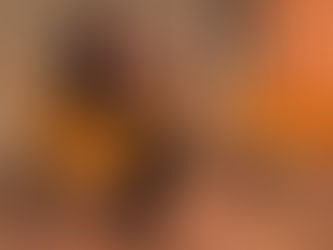







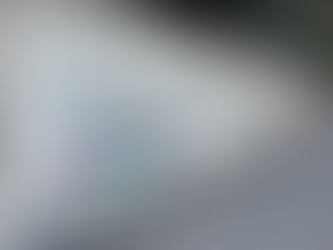












































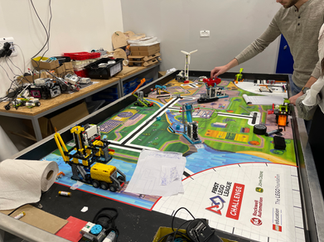









































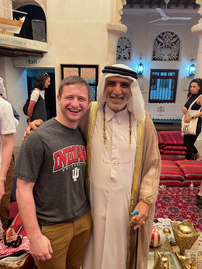





























































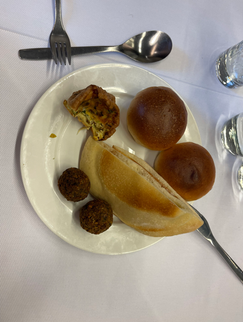







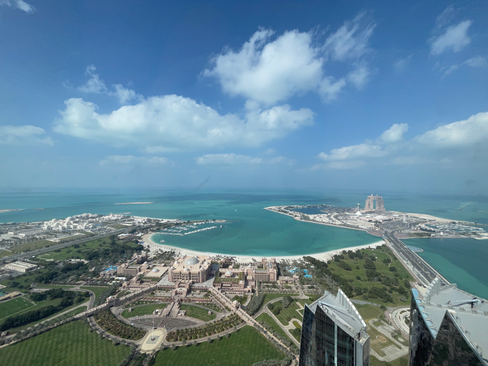











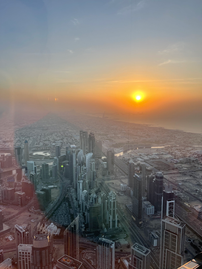








Comments